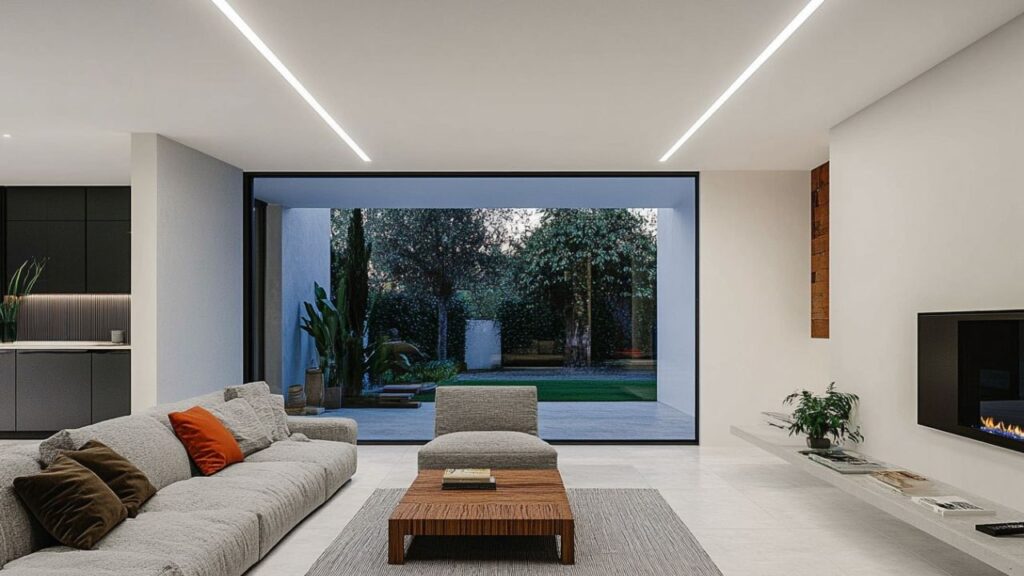The implementation of indirect LED lighting through a floating ceiling system produces an advanced method to upgrade space ambiance. The lighting method uses hidden LED strips or recessed lighting to create the appearance of suspended ceilings through soft diffused illumination along the edges. Modern interior design frequently uses this technique which enhances depth and elegance in residential and hotel spaces as well as restaurants and commercial buildings. The room looks bright and modern with indirect led ceiling lighting.
Understanding the Floating Ceiling Concept
The design of a floating ceiling creates an illusion of suspended levitation above primary building structures. A secondary ceiling installed beneath the main ceiling creates an opening around its edges to position LED lights to achieve this effect. The lighting system installed behind the ceiling creates an illusion of weightlessness which produces a modern and visually pleasing effect. The lighting technique functions effectively in homes and businesses and specifically benefits spaces with short ceilings because it generates an open and taller appearance.
Planning the Floating Ceiling Design
The correct execution of floating ceiling designs requires careful planning from the beginning. The planning process starts by measuring the ceiling height and deciding the dimensions of the drop-down element. The distance between the principal ceiling and the suspended section needs to be broad enough to distribute light properly yet narrow enough to preserve the floating appearance. The size of the gap between ceiling levels determines the lighting effect intensity and typically measures between two to six inches. Material selection stands as a vital component during the design process. Plasterboard together with gypsum and lightweight wood panels serve as the primary materials for building floating ceilings. The materials work well for shaping and installation and they seamlessly integrate with LED lighting systems. A strong yet lightweight ceiling structure remains essential because it prevents unnecessary stress on the current ceiling framework.
Choosing the Right LED Lighting
The selection of proper LED lighting systems determines the outcome of the project. LED strip lights represent the preferred option because they offer flexible design and energy-efficient operation alongside multiple color temperature options. The color temperature of LEDs determines whether the space feels cozy through warm white or modern through cool white or daylight white. RGB LED strips enable users to select different colors through their programming system which can adapt to various moods and special events. The dimmable functionality of LED strips allows users to adjust their brightness settings. The selection of LED strips with high lumens per watt rating delivers sufficient brightness while avoiding excessive illumination in the space. The selection of LEDs with a high color rendering index (CRI) helps maintain accurate color representation in surrounding decorative elements.
Installing the Floating Ceiling and LED Lighting
The installation requires building the floating ceiling framework followed by precise placement of LED lights. The foundation starts with constructing a perimeter frame from wooden battens or metal channels that must be firmly fixed to the main ceiling or walls. The framework receives the floating panel which creates an opening where the lighting will be installed. The installation of LED strips begins after constructing the floating ceiling framework by placing them inside its edges. The installation process becomes simpler with adhesive-backed LED strips yet additional brackets or clips should be used for long-term security against detachment. The wiring needs to be hidden properly inside the ceiling framework to achieve a smooth and unbroken appearance. It is advisable to provide easy access to power adapters and dimmer switches when LEDs require them for maintenance purposes.
Enhancing the Lighting Effect
The floating ceiling effect becomes more impactful when LED lighting receives proper strategic placement together with complementary design elements. The use of reflective materials including glossy paint mirrors and metallic finishes will enhance light distribution to create dramatic visual effects. Users can adjust lighting intensity through the dimmer system to meet their needs in various situations. The combination of recessed downlights with pendant fixtures, and wall sconces adds depth and functional value to the complete design. Users benefit from automated lighting control through remote features which combine convenience with energy savings when their indirect LED lighting systems connect to smart home systems.
Benefits of a Floating Ceiling with Indirect LED Lighting
The combination of a floating ceiling system with indirect LED lighting provides benefits that extend past visual appeal. The gentle illumination from this lighting system produces a welcoming environment by minimizing both glare and shadow intensity. The energy-efficient nature of LED strips emerges from their ability to consume less power than conventional lighting sources while using this lighting technique. The extended operational period of these fixtures reduces maintenance expenses which leads to lower long-term costs. The floating ceiling effect produces an expanded appearance through enhanced spatial perception to improve both small and low-ceilinged rooms. Commercial businesses employ this technique to improve their retail areas and hotel and restaurant spaces as well as create an upscale environment that attracts customers. The versatility of lighting design improves because LED color modification and brightness level adjustment capabilities become available.
Maintenance and Long-Term Considerations
The lifespan of a floating ceiling system with indirect LED lighting depends on regular maintenance checks and occasional inspections. Regular cleaning of LED strips and ceiling surfaces with a soft cloth or duster prevents the reduction of the lighting effect caused by dust accumulation. Periodic checks of LED connections and power supply help prevent both light flickering and power failures. The use of dimmable or RGB LED strips requires checking control system compatibility to prevent technical problems. High-quality LEDs with proper heat dissipation systems extend their operational life and reduce the frequency of replacements. The implementation of these preventive measures ensures the floating ceiling effect will continue to be both visually appealing and operational for multiple years.
Conclusion
A floating ceiling effect achieved through indirect LED lighting serves as an advanced technique to completely revamp the space’s appearance. A suspended ceiling effect becomes achievable through detailed planning along with the right materials and precise LED light positioning. The contemporary lighting approach provides both visual appeal and an improved atmosphere together with energy-efficient operation and a better perception of space dimensions. The combination of floating ceilings with indirect LED lighting creates an elegant and sophisticated design element that improves the entire design experience in residential and commercial spaces.







